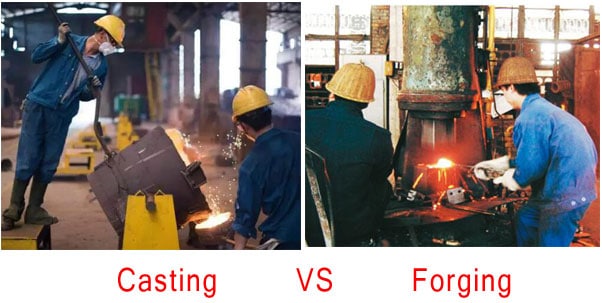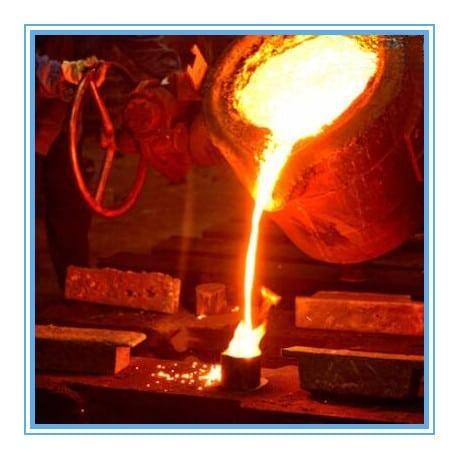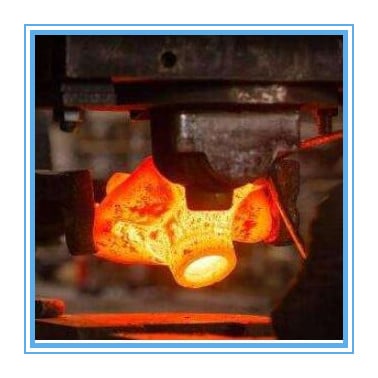Casting vs. Forging: Understanding the Differences
In the realm of metal component manufacturing, two prominent methods stand out: casting and forging. These processes hold distinct advantages and are selected based on the intended use and requirements of the metal part. This article explores the nuances of casting and forging, aiding you in making an informed choice for your specific needs, ultimately enhancing the quality of your products.

Casting:
Casting involves heating metal until it becomes molten, then pouring or injecting it into a molded vessel to create the desired shape. This method is particularly beneficial for crafting large-sized components, as it allows for the easy attainment of net shapes or similar configurations, reducing the need for extensive post-machining. Casting processes can be categorized by the type of mold or the pressure used to fill the mold with molten metal. By selecting the appropriate alloys, casting can achieve high-temperature heat treatment, resulting in materials with superior strength and durability. However, the solidification process in casting can lead to microstructural adjustments, including grain structure, phase transformations, and precipitation. It is not without its drawbacks, as defects like shrinkage porosity, cracks, and segregation can impact mechanical properties, necessitating subsequent heat treatments for optimal performance.
Advantages of Casting:
Greater flexibility in shaping metal components.
Cast parts are generally lighter than forged counterparts.
Initial results often meet design specifications, reducing the need for secondary machining.
Suitable for smaller production runs.
Ideal for large and complex components.
Tooling costs are often lower than those of forging.
No upper size limit for casting weight.
A wide range of alloy choices, including additives like Chrome, Nickel, and Mo.

Types of Casting:
Investment Casting
Casting is a preferred method for crafting large, intricate, or otherwise unsuitable wear parts and components for the forging process.
Forging:
Forging is a metal forming process that does not involve heating. It relies on the application of thermal and mechanical energy to steel billets or ingots, which are then hammered and manipulated into the final desired shape. Forgings tend to be stronger than castings, although they are less suitable for complex components. When forging is required for a component meeting specific size requirements, additional machining may be necessary. The forging process can be performed at various temperatures, including cold, warm, and hot, depending on the material's characteristics. Forging results in metallurgical changes and grain refinement, enhancing impact and shear strength. Forged steel is generally more reliable and robust than castings or plate steel due to the alteration of grain flow.
Advantages of Forging:
Superior structural integrity and mechanical strength.
Cost savings due to reduced labor and material scrap.
Eliminates surface defects like porosity, voids, and cold pour issues.
Excellent impact resistance.
Consistency in producing incredibly strong and ductile parts.
Tight grain structure, reducing the need for expensive alloys.
Enhanced wear resistance.

Types of Forging:
Open Die Forging
Closed Die Forging
Differences between Casting and Forging:
Strength Difference: Casted materials are generally weaker, while forged materials are stronger due to their specific grain structure.
Suitability for Hollow Shapes: Casting is favored for components with hollow spaces, while forging excludes cavities and porosity.
Uniformity: Casted materials may not always be uniform, while forging offers consistency in shape.
Size Restrictions: Casting has no size or shape limitations, while materials weighing over 50kg may require forging.
Level of Complexity: Casting allows for complex shapes, while forging focuses on simplicity and uniformity.
Cost: Casting equipment is relatively less expensive than the machines used for forging.
Researchers at the University of Toledo found that forged parts exhibited higher tensile and fatigue strength compared to cast parts. Forged steel was also found to be stronger and more ductile, with significant advantages in terms of mechanical properties.
In conclusion, understanding the differences between casting and forging is crucial for selecting the appropriate method for your specific product needs. By considering factors such as size, complexity, and desired material properties, you can make an informed decision to enhance the quality of your components.
Dongrun Casting have 20000 square meters facility houses and 200 production & test equipment, From quotation and tooling design to casting and finished machining, we can work with you at every stage. We serves wide range of industries-from Fortune 500 corporations to small and midsize OEMs. Our products includes: Automotive&Trucking, Electric Utility & Communications, Metering System, Hydraulic Industry, Medical Devices, Lighting, Fuel and Gas Pressure, Furniture parts.
More Details : www.dongruncasting.com
